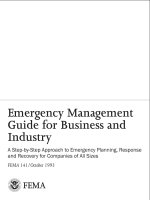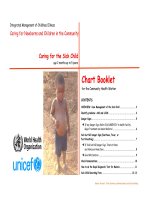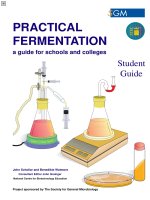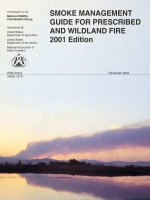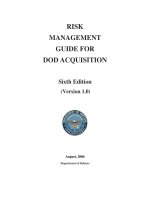SMOKE MANAGEMENT GUIDE FOR PRESCRIBED AND WILDLAND FIRE 2001 EDITION doc
Bạn đang xem bản rút gọn của tài liệu. Xem và tải ngay bản đầy đủ của tài liệu tại đây (6.71 MB, 236 trang )
SMOKE MANAGEMENT GUIDE FOR
PRESCRIBED AND WILDLAND FIRE
2001 Edition
EDITORS/COMPILERS: PRODUCED BY:
Colin C. Hardy National Wildfire Coordinating Group
Roger D. Ottmar Fire Use Working Team
Janice L. Peterson
John E. Core
Paula Seamon
Additional copies of this publication may be ordered by mail/fax from:
National Interagency Fire Center, ATTN: Great Basin Cache Supply Office
3833 S. Development Avenue
Boise, Idaho 83705. Fax: 208-387-5573.
Order NFES 1279
An electronic copy of this document is available at .
________________________________________________________________________
The National Wildfire Coordinating Group (NWCG) has developed this information for the guidance of its member agencies and
is not responsible for the interpretation or use of this information by anyone except the member agencies. The use of trade, firm,
or corporation names in this publication is for the information and convenience of the reader and does not constitute an endorse-
ment by NWCG of any product or service to the exclusion of others that may be suitable.
– i –
2001 Smoke Management Guide Forward
Forward
The National Wildfire Coordinating Group’s (NWCG) Fire Use Working Team
1
has assumed overall
responsibility for sponsoring the development and production of this revised Smoke Management
Guide for Prescribed and Wildland Fire (the “Guide”). The Mission Statement for the Fire Use Work-
ing Team includes the need to coordinate and advocate the use of fire to achieve management objec-
tives, and to promote a greater understanding of the role of fire and its effects. The Fire Use Working
Team recognizes that the ignition of wildland fuels by land managers, or the use of wildland fires
ignited by natural causes to achieve specific management objectives is receiving continued emphasis
from fire management specialists, land managers, environmental groups, politicians and the general
public. Yet, at the same time that fire use programs are increasing, concerns are being expressed
regarding associated “costs” such as smoke management problems. This revised Guide is the Fire Use
Working Team’s contribution to a better national understanding and application of smoke management.
Bill Leenhouts—Chair
NWCG Fire Use Working Team
___________________________________
1
The NWCG website [] contains documentation and descriptions for all NWCG working teams.
Preface 2001 Smoke Management Guide
– ii –
– iii –
2001 Smoke Management Guide Preface
Preface
The National Wildfire Coordinating Group’s Fire Use Working Team sponsored this 2001 edition of the
Smoke Management Guide for Prescribed and Wildland Fire. A six-member steering committee was
responsible for development of a general outline and for coordination of the Guide’s production. The
editors/compilers invited the individual contributions, edited submissions, authored many of the sec-
tions, obtained comprehensive reviews from the NWCG agencies and other partners, and compiled the
final material into a cohesive guidebook.
Steering Committee: Bill Leenhouts (chair, NWCG Fire Use Working Team), Colin C. Hardy, Roger
D. Ottmar, Janice L. Peterson, John E. Core, Paula Seamon.
Authors:
Gary Achtemeier, Research Meteorologist,
USDA Forest Service, Southern Research
Station. Athens, GA
James D. Brenner, Fire Management Adminis-
trator, State of Florida Dept. of Agriculture and
Consumer Service, Division of Forestry,
Tallahassee, FL
John E. Core, Consultant, Core Environmental
Consulting. Portland, OR
Sue A. Ferguson, Research Atmospheric Scien-
tist, USDA Forest Service, Pacific Northwest
Research Station. Seattle, WA
Colin C. Hardy, Research Forester
USDA Forest Service, Rocky Mountain Re-
search Station. Missoula, MT
Sharon M. Hermann, Research Ecologist,
Department of Biological Sciences, Auburn
University. Auburn, AL
Bill Jackson, Air Resource Specialist, USDA
Forest Service, Region 8, Asheville, NC
Peter Lahm, Air Resource Program Manager,
USDA Forest Service, Arizona National Forests.
Phoenix, AZ
Bill Leenhouts, Fire Ecologist, USDI Fish and
Wildlife Service, National Interagency Fire
Center. Boise, ID
Tom Leuschen, Owner—Fire Vision, USDA
Forest Service, Okanagon National Forest.
Okanagon, WA
Robert E. Mutch, Consultant Forester, Sys-
tems for Environmental Management. Missoula,
MT
Roger D. Ottmar, Research Forester, USDA
Forest Service, Pacific Northwest Research
Station. Seattle, WA
Janice L. Peterson, Air Resource Specialist,
USDA Forest Service, Mt. Baker-Snoqualmie
National Forest. Mountlake Terrace, WA
Timothy R. Reinhardt, Industrial Hygienist,
URS Corp. Bellevue, WA
Paula Seamon, Fire Management Coordinator,
The Nature Conservancy, Fire Management
Program. Tallahassee, FL
Dale Wade, Research Forester,
USDA Forest Service, Southern Research
Station. Athens, GA
Preface 2001 Smoke Management Guide
– iv –
– v –
2001 Smoke Management Guide Table of Contents
Table of Contents
Forward i
Bill Leenhouts—Chair, NWCG, Fire Use Working Team
Preface iii
1.0 Introduction 3
Colin C. Hardy
Bill Leenhouts
2.0 Overview
2.1 The Wildland Fire Imperative 11
Colin C. Hardy
Sharon M. Hermann
Robert E. Mutch
2.2 The Smoke Management Imperative 21
Colin C. Hardy
Sharon M. Hermann
John E. Core
3.0 Smoke Impacts
3.1 Public Health and Exposure to Smoke 27
John E. Core
Janice L. Peterson
3.2 Visibility 35
John E. Core
3.3 Problem and Nuisance Smoke 41
Gary L. Achtemeier
Bill Jackson
James D. Brenner
3.4 Smoke Exposure Among Fireline Personnel 51
Roger D. Ottmar
Timothy R. Reinhardt
Table of Contents 2001 Smoke Management Guide
– vi –
4.0 Regulations
4.1 Regulations For Smoke Management 61
Janice L. Peterson
4.2 State Smoke Management Programs 75
John E. Core
4.3 Federal Land Management - Special Requirements 81
Janice L. Peterson
5.0 Smoke Source Characteristics 89
Roger D. Ottmar
6.0 Fire Use Planning 109
Tom Leuschen
Dale Wade
Paula Seamon
7.0 Smoke Management Meteorology 121
Sue A. Ferguson
8.0 Smoke Management:
Techniques to Reduce or Redistribute Emissions 141
Roger D. Ottmar
Janice L. Peterson
Bill Leenhouts
John E. Core
9.0 Smoke Dispersion Prediction Systems 163
Sue A. Ferguson
10.0 Air Quality Monitoring for Smoke 179
John E. Core
Janice L. Peterson
11.0 Emission Inventories 189
Janice L. Peterson
12.0 Smoke Management Program Administration and Evaluation 201
Peter Lahm
Appendix A – Glossary of Fire and Smoke Management Terminology 209
– 1 –
2001 Smoke Management Guide Introduction
INTRODUCTION
Chapter 1
Chapter 1 – Introduction 2001 Smoke Management Guide
– 2 –
– 3 –
2001 Smoke Management Guide Introduction
Introduction
Colin C. Hardy
Bill Leenhouts
Why Do We Need A National Smoke Management Guide?
As an ecological process, wildland fire is essen-
tial in creating and maintaining functional
ecosystems and achieving other land use objec-
tives. As a decomposition process, wildland fire
produces combustion byproducts that are harm-
ful to human health and welfare. Both the land
management benefits from using wildland fire
and the public health and welfare effects from
wildland fire smoke are well documented. The
challenge in using wildland fire is balancing the
public interest objectives of protecting human
health and welfare and sustaining ecological
integrity.
Minimizing the adverse effects of smoke on
human health and welfare while maximizing the
effectiveness of using wildland fire is an inte-
grated and collaborative activity. Everyone
interested in natural resource management is
responsible and has a role. Land managers need
to assure that using wildland fire is the most
effective alternative of achieving the land
management objectives. State, regional, tribal
and national air resource managers must ensure
that air quality rules and regulations equitably
accommodate all legal emission sources.
The varied smoke management issues from
across the nation involve many diverse cultures
and interests, include a multitude of strategies
and tactics, and cover a heterogeneous land-
scape. No national answer or cookbook ap-
proach will adequately address them. But
people with a desire for responsible smoke
management working in partnership with the
latest science-based smoke management infor-
mation can fashion effective regional smoke
management plans and programs to address
their individual and collective objectives. The
intent of the Guide is to provide the latest
science-based smoke management information
from across the nation to facilitate these col-
laborative efforts.
Awareness of smoke production, transport, and
effects on receptors from prescribed and wild-
land fires will enable us to refine existing smoke
management strategies and to develop better
smoke management plans and programs in the
future. This Guide addresses the basic control
strategies for minimizing the adverse effects of
smoke on human health and welfare—thus
maximizing the effectiveness of using wildland
fire. These control strategies are:
• Avoidance – using meteorological condi-
tions when scheduling burning in order to
avoid incursions of wildland fire smoke
into smoke sensitive areas.
• Dilution – controlling the rate of emissions
or scheduling for dispersion to assure
tolerable concentrations of smoke in
designated areas.
Chapter 1 – Introduction 2001 Smoke Management Guide
– 4 –
• Emissions-reduction – using techniques to
minimize the smoke output per unit area
treated and decrease the contribution to
regional haze as well as intrusions into
designated areas.
Guide Goals and
Considerations
The Smoke Management Guide steering com-
mittee and the NWCG Fire Use Working Team
developed this Guide with the following goals:
• Provide fire use practitioners with a
fundamental understanding of fire-emis-
sions processes and impacts, regulatory
objectives, and tools for the management
of smoke from wildland fires.
• Provide local, state, tribal, and federal air
quality managers with background infor-
mation related to the wildland fire and
emissions processes and air, land and
wildland fire management.
The following considerations provide the con-
text within which these goals can be met:
• This document is about smoke manage-
ment, not about the decision to use wild-
land fire or its alternatives. Its purpose is
not to advocate for or against the use of
fire to meet land management objectives.
• While the Guide contains relevant back-
ground material and resources generally
useful to development of smoke manage-
ment programs, it is not a tutorial on how
to develop a state smoke management
program.
• Although the Guide is replete with infor-
mation and examples for potential applica-
tion at the local and regional level, the
Guide generally focuses on national smoke
management principles. For maximum
benefit to local or regional applications,
appropriate supplements should be devel-
oped for the scale or geographical location
of the respective application.
• The Guide is more appropriate for knowl-
edgeable air, land, and wildland fire
managers, and is not intended for novice
readers.
Overview and
Organization of the Guide
The Smoke Management Guide for Prescribed
and Wildland Fire–2001 Edition follows a
textbook model so that it can be used as a
supplemental reference in smoke management
training sessions and courses such as the
NWCG Smoke Management course, RX-410
(formerly RX-450). Following an Introduc-
tion, a background chapter presents a primer on
wildland fire and a discussion of the imperatives
for smoke management. In the Wildland Fire
Imperative, the Guide addresses both the
ecological and societal aspects of wildland fire
(not agricultural, construction debris, or other
biomass burning), and provides the details
necessary for fire use practitioners and air
quality managers to understand the fundamen-
tals of fire in wildlands. The Smoke Manage-
ment Imperative discusses the needs for smoke
management as well as its benefits and costs.
The background sections are followed by chap-
ters presenting details on Wildland Fire Smoke
Impacts—public health, visibility, problem and
nuisance smoke, and smoke exposure among
fireline personnel—and on Regulations for
Smoke Management. The chapter on Smoke
Source Characteristics follows a sequence
similar to the basic pathway that smoke produc-
– 5 –
2001 Smoke Management Guide Introduction
___________________________________
1
For a comprehensive presentation of fire terminology, the reader should refer to the NWCG Glossary of Wildland
Fire Terminology (NWCG 1996—PMS #205, Boise, ID).
tion does—from the pre-fire fuel characteristics
and the fire phenomenon as an emissions
source, through the processes of combustion,
biomass consumption and emissions production.
The chapter on Fire Use Planning addresses
important considerations for developing a
comprehensive fire use plan (a “burn plan”).
The general planning process is reviewed, from
developing a general land use plan, through a
fire management plan and, ultimately, to a unit-
specific burn plan.
The Smoke Management Meteorology chapter
presents a primer on the use of weather observa-
tions and forecasts, and then provides informa-
tion regarding the transport and dispersion of
smoke from wildland fires.
Techniques to Reduce or Redistribute Emis-
sions are presented in an exhaustive list and
synthesis of emissions reduction and impact
reduction practices and techniques. These
practices and techniques were initially compiled
as the outcomes of three regional workshops
held specifically for the purpose of synthesizing
current and potential smoke management tools.
Presented here in a nationally applicable format,
they are the fundamental tools available to fire
planners and fire use practitioners for the man-
agement and mitigation of smoke from wildland
fires.
The Smoke Dispersion Prediction Systems
chapter reviews current prediction tools within
the context of three “families” of model applica-
tions—screening, planning, or regulating.
Air Quality Monitoring for Smoke discusses
various objectives for monitoring, and empha-
sizes the need to carefully match the monitoring
objective with the appropriate equipment. In
addition, the chapter presents information on
some common monitoring equipment, methods,
and their associated costs.
Emission Inventories help managers and
regulators understand how to better include fire
in an emissions inventory. This chapter dis-
cusses the use of the three basic elements
needed to perform an emission inventory—area
burned, fuel consumed, and appropriate emis-
sion factor(s).
No smoke management effort can succeed
without continued assessment and feedback.
The chapter on Program Administration and
Assessment discusses the need to maintain a
balance between the level of effort in a program
and the level of prescribed or fire use activity as
well as their associated local or regional effects.
Each section in this Guide is now supported by
an extensive list of relevant references. Also,
authorship for a specific section is given in the
table of contents, where appropriate. In such
cases, the section can be cited with its respective
author(s) as an independent “chapter” in the
Guide.
A glossary of frequently used fire and smoke
management terms
1
is provided as an appendix
to the Guide.
History of Smoke
Management Guidance
The first guidance document specifically ad-
dressing the management of smoke from pre-
scribed fires was the Southern Smoke
Management Guidebook, produced in 1976 by
the Southern Forest Fire Laboratory staff
Chapter 1 – Introduction 2001 Smoke Management Guide
– 6 –
___________________________________
2
The Joint Fire Sciences Program is sponsoring extensive revisions to the Rainbow Series fire effects volumes,
including a new volume on fire effects on air.
(1976). It was a comprehensive treatment of the
various aspects fire behavior, emissions, trans-
port and dispersion, and the management of
smoke in the southern United States.
In 1985, NWCG’s Prescribed Fire and Fire
Effects Working Team developed the widely
accepted Prescribed Fire Smoke Management
Guide that forms the basis for this 2001 revised
Guide (NWCG 1985). The 1985 edition fo-
cused on national smoke management principles
and, as a result, was far less comprehensive than
the Southern guidebook.
One of six state-of-knowledge reports prepared
for the 1978 National Fire Effects Workshop is a
review called Effects of Fire on Air (USDA
Forest Service 1978). The six volumes, called
the “Rainbow Series” on fire effects, were in
response to the changes in policies, laws, regula-
tions, and initiatives. Objectives specific to the
volume on air were to: “…summarize the
current state-of-knowledge of the effects of
forest burning on the air resource, and to define
research questions of high priority for the
management of smoke from prescribed and wild
fires” (USDA Forest Service 1978, p.5).
2
Conflicts between prescribed fire and air quality
began to be seriously addressed in the mid-
1980s. Prior to this, only a few states had
developed or implemented smoke management
programs, and national-level policies addressing
smoke from wildland burns were only beginning
to be drafted. Much has changed since then,
with numerous policies and initiatives raising
the potential for conflicting resource manage-
ment objectives—principally air quality and
ecosystem integrity. The Clean Air Act amend-
ments adopted in 1990 specifically addressed
regional haze. Smoke Management Plans have
been developed by many states as administrative
rules enforceable under state law. These rules
are often incorporated into State and Tribal
Implementation Plans (SIPs and TIPs) for
submission to the U.S. Environmental Protec-
tion Agency (EPA) and, once promulgated by
EPA, are then enforceable under federal law as
well. And now, the role of fire and the need for
its accelerated use has become widely recog-
nized with respect to maintenance and restora-
tion of fire-adapted ecosystems. These issues
all point to the imperative for better knowledge
and more informed collaboration between
managers of both the air and terrestrial re-
sources.
The 2001 Edition of the Smoke
Management Guide
Recognizing the increasing likelihood of im-
pacting the public, the proliferation of federal,
state, and local statutes, rules and ordinances
pertaining to smoke, as well as major improve-
ments to our knowledge of smoke and its man-
agement, the NWCG Fire Use Working Team
(formerly named the Prescribed Fire and Fire
Effects Working Team) sponsored revision of
the Guide. Conceptually, the Fire Use Working
Team identified the need for a revised guide-
book that targeted not just prescribed fire practi-
tioners, but state and local air quality and public
health agency personnel as well. A consequence
of this expansion of the target audience was the
need to substantially augment the background
information with respect to fire in wildlands.
A suite of potential smoke management prac-
tices and techniques are not only suggested in
– 7 –
2001 Smoke Management Guide Introduction
this Guide, but their relative effectiveness and
regionally-specific applicability are also pro-
vided. This information was acquired through
three regional workshops held in collaboration
with the U.S. Environmental Protection
Agency’s Office of Air Quality Planning and
Standards.
This revised Guide now emphasizes both emis-
sion and impact reduction methods that have
been found to be practical, useful, and benefi-
cial. This new emphasis on reducing emissions
is in response to regional haze and fine particle
(PM
2.5
) control programs that will require
emission reductions from a wide variety of
pollution sources (including prescribed and
wildland fire). This is especially important in
view of the major increases in the use of fire
projected by federal land managers. Readers
will also find a greatly expanded discussion of
air quality regulatory requirements, reflecting
the growing complexities and demands on
today’s fire practitioners.
Literature Citations
NWCG. 1985. Prescribed fire smoke management
guide. NWCG publication PMS-420-2. Boise,
ID. National Wildfire Coordinating Group.
28 p.
Southern Forest Fire Laboratory Staff. 1976. South-
ern forestry smoke management guidebook.
USDA For. Serv. Gen. Tech. Rep. SE-10.
Asheville, N.C. USDA Forest Service, South-
east Forest Experiment Station. 140 p.
USDA Forest Service. 1978. Effects of fire on air.
USDA For. Serv. Gen. Tech. Rep. WO-9.
Washington, D.C. USDA Forest Service. 40 p.
Chapter 2 – Overview 2001 Smoke Management Guide
– 8 –
– 9 –
2001 Smoke Management Guide 2.1 – The Wildland Fire Imperative
OVERVIEW
Chapter 2
Chapter 2 – Overview 2001 Smoke Management Guide
– 10 –
– 11 –
2001 Smoke Management Guide 2.1 – The Wildland Fire Imperative
The Wildland Fire Imperative
Colin C. Hardy
Sharon M. Hermann
Robert E. Mutch
Perpetuating America’s Natural Heritage: Balancing
Wildland Management Needs and the Public Interest
Strategies for responsible and effective smoke
management cannot be developed without
careful consideration of the ecological and the
societal impacts of fire management in the
wildlands of modern America. The need to
consider both perspectives is acknowledged by
most land management agencies, as well as by
the U.S. Environmental Protection Agency
(EPA) —the primary Federal agency responsible
for protecting air quality. An awareness of this
challenge is reflected in NWCG’s education
message, Managing Wildland Fire: Balancing
America’s Natural Heritage and the Public
Interest (NWCG 1998). The preamble to this
document not only states that “fire is an impor-
tant and inevitable part of America’s wildlands,”
but also recognizes that “wildland fires can
produce both benefits and damages—to the
environment and to people’s interests.”
The EPA’s Interim Air Quality Policy on Wild-
land and Prescribed Fires (U.S. EPA 1998)
employs similar language to describe related
public policy goals: (1) To allow fire to function,
as nearly as possible, in its natural role in
maintaining healthy wildland ecosystems; and,
(2) To protect public health and welfare by
mitigating the impacts of air pollutant emissions
on air quality and visibility. The document
comments on the responsibilities of wildland
owners/managers and State/tribal air quality
managers to coordinate fire activities, minimize
air pollutant emissions, manage smoke from
prescribed fires as well as wildland fires used
for resource benefits, and establish emergency
action programs to mitigate the unavoidable
impacts on the public. In addition, EPA asserts
that “this policy is not intended to limit opportu-
nities by private wildland owners/managers to
use fire so that burning can be increased on
publicly owned wildlands.”
In this and the following section (2.2–The
Smoke Management Imperative), we outline
both ecological and societal aspects of wildland
and prescribed fire. We review the historical
role and extent of fire and the effects of settle-
ment and land use changes. The influence of
fire exclusion policies on historical disturbance
processes is considered in light of modern
landscape conditions. This provides the basis
for discussion of significant, recent changes in
Federal wildland fire policy and new initiatives
for accelerating use of prescribed and wildland
fire to achieve resource management objectives.
Finally, we present examples of the impacts of
Chapter 2 – Overview 2001 Smoke Management Guide
– 12 –
wildland smoke on air quality, human health,
and safety.
Fire in Wildlands
Recurring fires are often an essential component
of the natural environment—as natural as rain,
snow, or wind. Evidence for the recurrence of
past fires is found in charcoal layers of lakes and
bogs, in fire-scars of trees, and in the morpho-
logical and life history adaptations of numerous
native plants and animals. Many ecosystems in
North America and throughout the world are
fire-dependent (Heinselman 1978) and periodic
burning is essential for healthy ecosystem
functioning in these wildlands. Fire acts at the
individual, population, and community levels
and can influence:
• Plant succession.
• Fuel accumulation and decay.
• Recruitment pattern and age distribu-
tion of individuals.
• Species composition of vegetation.
• Disease and insect pathogens.
• Nutrient cycles and energy flows.
• Biotic productivity, diversity, and
stability.
• Habitat structure for wildlife.
For millennia, lightning, volcanoes, and people
have ignited fires in wildland ecosystems. The
current emphasis on ecosystem management
calls for the maintenance of interactions be-
tween such disturbance processes and ecosys-
tem functions. Therefore, it is incumbent on
both fire and natural resource managers to
understand the range of historical frequency,
severity, and aerial extent of past burns. This
knowledge provides a frame of reference for
applying appropriate management practices on a
landscape scale, including the use and exclusion
of fire.
Many studies have described the historical
occurrence of fires throughout the world. For
example, Swetnam (1993) used fire scars to
describe a 2000-year period of fire history in
giant sequoia groves in California. He found
that frequent small fires occurred during a warm
period from about A.D. 1000 to 1300, and less
frequent but more widespread fires occurred
during cooler periods from about A.D. 500-1000
and after 1300. Swain (1973) determined from
lake sediment analyses in the Boundary Waters
Canoe Area in Minnesota that tree species and
fire had interacted in complex ways over a
10,000-year period. Other studies ranging from
Maine (e.g. Copenheaver and others 2000) to
Florida (e.g. Watts and others 1992) have em-
ployed pollen and charcoal deposits to demon-
strate shifts in fire frequency correlated with the
onset of European settlement.
There is an even larger body of science that
details the numerous effects of wildland fires on
components of ecosystems. Some of the most
compelling examples of fire dependency come
from studies on plant reproduction and estab-
lishment. For instance, there are at least ten
species of pines scattered over the United States
that have serotinous cones; that is to say the
cones are sealed by resin; the cone scales do not
open and seeds do not disperse until the resin is
exposed to high heat (reviewed in Whelan
1995). Examples of fire dependency in herba-
ceous plants include flowering of wiregrass in
Southeastern longleaf pine forests that is greatly
enhanced by growing season burns (Myers
1990) and seed germination of California
chaparral forbs that is triggered by exposure to
smoke (Keeley and Fotheringham 1997). Ani-
mals as diverse as rare Karner blue butterflies in
Indiana (Kwilosz and Knutson 1999) to whoop-
ing cranes in Texas (Chavez Ramirez and others
1996) benefit when fire is re-introduced into
their habitats. There are numerous other types
of fire dependency in North American ecosys-
– 13 –
2001 Smoke Management Guide 2.1 – The Wildland Fire Imperative
tems and many studies on this topic are summa-
rized in books and government publications
(e.g. Agee 1993, Bond and van Wilgen 1996,
Brown and Kapler Smith 2000, Johnson 1992,
Kapler Smith 2000, Wade and others 1980,
Whelan 1995). In addition, there is a small but
growing volume of literature that evaluates the
influence of fire on multiple trophic levels (e.g.
Hermann and others 1998).
Knowledge of fire history, fire regimes, and fire
effects allows land stewards to develop informed
management strategies. Application of fire may
be one of the tools used to meet resource man-
agement objectives. The role of fire as an
important disturbance process has been high-
lighted in a classification of continental fire
regimes (Kilgore and Heinselman 1990). These
authors describe a natural fire regime as the total
pattern of fires over time that is characteristic of
a region or ecosystem. Fire regimes are defined
in terms of fire type and severity, typical fire
sizes and patterns, and fire frequency, or length
of return intervals in years. Kilgore and
Heinselman (1990) placed natural fire regimes
of North America into seven classes, ranging
from Class 0, in which fires are rare or absent,
to Class 6, in which crown fires and severe
surface fires occur at return intervals longer than
300 years. Intermediate fire regimes, Classes 1-
5, are characterized by increasingly longer fire
return intervals and increasingly higher fire
intensities. Class 2, for example, describes the
situation for long-needled pines, like longleaf
pine, ponderosa pine, and Jeffrey pine; in this
class low severity, surface fires occur rather
frequently (return intervals of less than 25
years). Lodgepole pine, jackpine, and the boreal
forest of Canada and Alaska generally fall into
Class 4, a class in which high severity crown
fires occur every 25 to 100 years; or into Class
5, a class in which crown fires occur every 100
to 300 years. White bark pine forests at high
elevations typically fall into Class 6. For com-
parison, three general classes of fire are shown
in figure 2.1, including a low-intensity surface
fire, a mixed-severity fire, and a stand-replacing
crown fire.
Figure 2.1. The relative difference in general classes of fire are shown. This
series illustrates a low-intensity surface fire (a), a mixed-severity fire (b), and a
stand-replacing crown fire (c).
(b)
(a)
(c)
Chapter 2 – Overview 2001 Smoke Management Guide
– 14 –
A noteworthy aspect of continental fire regimes
is that very few North American ecosystems fall
into Class 0. In other words, most ecosystems
in the United States have evolved under the
consistent influence of wildland fire, establish-
ing fire as a process that affects numerous
ecosystem functions described earlier. Those
who apply prescribed burns or use wildland fire
often attempt to mimic the natural role of fire in
creating or maintaining ecosystems. Sustaining
the productivity of fire-adapted ecosystems
generally requires application of prescribed fire
on a sufficiently large scale to ensure that
various ecosystem processes remain intact.
Ecological Effects of
Altered Fire Regimes
As humans alter fire frequency and severity,
many plant and animal communities experience
a loss of species diversity, site degradation, and
increases in the sizes and severity of wildfires.
Ferry and others (1995) concluded that altered
fire regimes was the principal agent of change
affecting vegetative structure, composition, and
biological diversity of five major plant commu-
nities totaling over 350 million acres in the U.S.
As a way to evaluate the current amount of fire
in wildland habitat, Leenhouts (1998) compared
estimated land area burned 200-400 years ago
(“pre-industrial”) to data from the contemporary
conterminous United States. The result suggests
that ten times more acreage burned annually in
the pre-industrial era than does in modern times.
After accounting for loss of wildland area due to
land use changes such as urbanization and
agriculture, Leenhouts concluded that the
remaining wildland is burned approximately
fifty percent less compared to fire frequency
under historical fire regimes (figure 2.2).
Numerous ecosystem indicators serve as alarm-
ing examples of the effects of altered fire re-
gimes. Land use changes, attempted fire
exclusion practices, prolonged drought, and
epidemic levels of insects and diseases have
coincided to produce extensive forest mortality,
or major changes in forest density and species
composition. Gray (1992) called attention to a
forest health emergency in parts of the western
Figure 2.2. Estimates of the range of annual area burned in the conterminous United States pre-European
settlement (Historic), applying presettlement fire frequencies to present land cover types (Expected), and
burning (wildland and agriculture) that has occurred during the recent past (Current). Source: Leenhouts
(1998).
– 15 –
2001 Smoke Management Guide 2.1 – The Wildland Fire Imperative
United States where trees have been killed
across millions of acres in eastern Oregon and
Washington. He indicated that similar problems
extend south into Utah, Nevada, and California,
and east into Idaho. Denser stands and heavy
fuel accumulations are also setting the stage for
high severity crown fires in Montana, Colorado,
Arizona, New Mexico, and Nebraska, where the
historical norm in long-needled pine forests was
for more frequent low severity surface fires (fire
regime Class 2; Kilgore and Heinselman 1990).
The paired photos in figure 2.3 illustrate 85
years of change resulting from fire exclusion on
a fire-dependent site in western Montana. In
North Carolina, Gilliam and Platt (1999) quanti-
fied the dramatic effects of over 80-years of fire
exclusion on tree species composition and stand
structure in a longleaf pine forest.
(a)
(b)
Figure 2.3. These two photos, taken of the same homestead near Sula, Montana, show 85 years of change on
a fire-dependent site where fire has been excluded. The top photo (a) was taken in 1895. By 1980 (b),
encroaching trees and shrubs occupy nearly all of the site. Stand-replacing crown fire visited this site in 2000.
